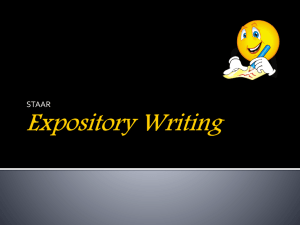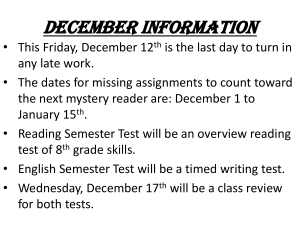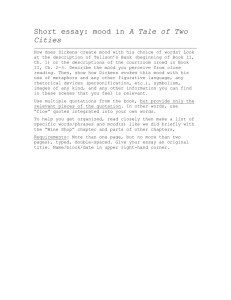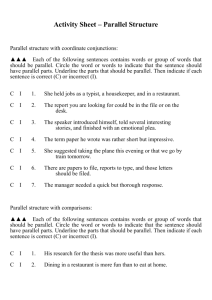Descriptive writing student notes
advertisement
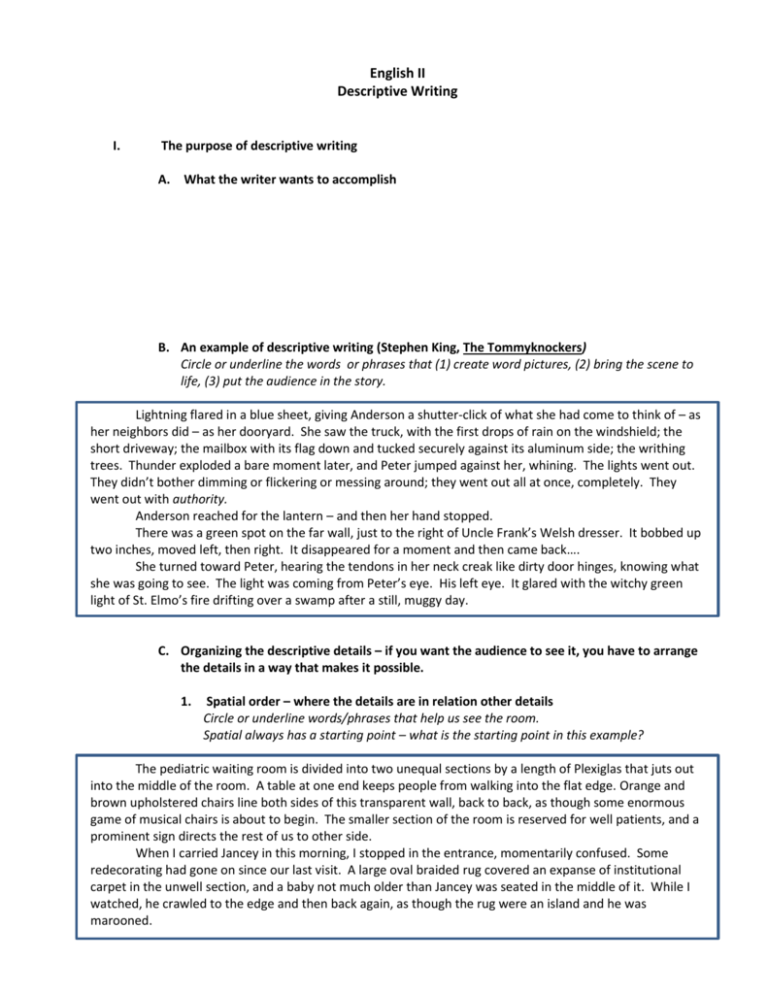
English II Descriptive Writing I. The purpose of descriptive writing A. What the writer wants to accomplish B. An example of descriptive writing (Stephen King, The Tommyknockers) Circle or underline the words or phrases that (1) create word pictures, (2) bring the scene to life, (3) put the audience in the story. Lightning flared in a blue sheet, giving Anderson a shutter-click of what she had come to think of – as her neighbors did – as her dooryard. She saw the truck, with the first drops of rain on the windshield; the short driveway; the mailbox with its flag down and tucked securely against its aluminum side; the writhing trees. Thunder exploded a bare moment later, and Peter jumped against her, whining. The lights went out. They didn’t bother dimming or flickering or messing around; they went out all at once, completely. They went out with authority. Anderson reached for the lantern – and then her hand stopped. There was a green spot on the far wall, just to the right of Uncle Frank’s Welsh dresser. It bobbed up two inches, moved left, then right. It disappeared for a moment and then came back…. She turned toward Peter, hearing the tendons in her neck creak like dirty door hinges, knowing what she was going to see. The light was coming from Peter’s eye. His left eye. It glared with the witchy green light of St. Elmo’s fire drifting over a swamp after a still, muggy day. C. Organizing the descriptive details – if you want the audience to see it, you have to arrange the details in a way that makes it possible. 1. Spatial order – where the details are in relation other details Circle or underline words/phrases that help us see the room. Spatial always has a starting point – what is the starting point in this example? The pediatric waiting room is divided into two unequal sections by a length of Plexiglas that juts out into the middle of the room. A table at one end keeps people from walking into the flat edge. Orange and brown upholstered chairs line both sides of this transparent wall, back to back, as though some enormous game of musical chairs is about to begin. The smaller section of the room is reserved for well patients, and a prominent sign directs the rest of us to other side. When I carried Jancey in this morning, I stopped in the entrance, momentarily confused. Some redecorating had gone on since our last visit. A large oval braided rug covered an expanse of institutional carpet in the unwell section, and a baby not much older than Jancey was seated in the middle of it. While I watched, he crawled to the edge and then back again, as though the rug were an island and he was marooned. 2. Emphatic order – details are arranged based on order of importance (This can also be called persuasive order.) What are the two things she remembers about where she grew up? Which seems the most important and why? When I think of the hometown of my youth, all that I seem to remember is dust – the brown, crumbly dust of the late summer—arid, sterile dust that gets into the eyes and makes them water, gets into the throat and between the toes of bare brown feet. I don’t know why I should remember only the dust. Surely there must have been lush green lawns and paved streets under the leafy shade trees somewhere in town, but memory is an abstract painting – it does not present things as they are, but rather as they feel. And so, when I think of that time and that place, I remember only the dry September of the dirt roads and grassless yard of the shanty town where I lived. And one other thing I remember, another incongruency of memory – a brilliant splash of sunny yellow against the dust – Miss Lottie’s marigolds. 3. Remember, chronological order might also be used in a descriptive essay if you are telling a story. D. Topic sentence – the sentence that tells what the paragraph will be about; all the details in the paragraph have to support that sentence. Circle the topic sentence. Underline the details that support that topic sentence. We were afraid at night in the winter. The upstairs of our house was not finished. A brick chimney went up one wall. In the middle of the floor was a square back hole, with a wooden railing around it; that was where the stairs came up. On the other side of the stairwell were the things nobody had any use for anymore…. I had told Laird, as soon as he was old enough to understand such things, that bats and skeletons lived over there; whenever a man escaped from the county jail, twenty miles away, I imagined that he had somehow let himself in the window and was hiding behind the linoleum. E. Putting it all together. Circle the topic sentence; underline the supportive details that paint a picture or bring the scene to life. Is it spatial order or emphatic order? Be able to defend your choice. Picture Canyon, though not the most beautiful of places, has a special, enigmatic effect on people. As you enter the canyon, the soft golden sandstone walls begin to build and loom overhead until they meet the electric-blue skyline. Native American drawings etched inside the canyon cover sheer cliff walls on either side, illustrating a past long since forgotten. The rugged floor of the canyon is scattered with multitudes of small algae-covered ponds with a few small weather-beaten sandstone roadways. Looking ahead, there are small wind-twisted pine trees with a multitude of squirrels feeding on the pea-sized pinon nuts. Each playfully eats his fill and stores the excess in bulging cheeks. As the sun sets over the horizon, the jagged, golden rock formations on the skyline seem to radiate an eerie, golden energy known only to a few infrequent visitors and to the Native Americans who lived in the canyon centuries ago. II. Sensory details and verb choice A. Sensory details B. Verb choice Below: Circle the strong verbs. Why are they descriptive? The nights now are full of wind and destruction; the trees plunge and bend and their leaves fly helter skelter until the lawn is plastered with them and they lie packed in gutters and choke rain pipes and scatter damp paths. C. Using the thesaurus Below: Circle the verb that is the better choice. Be ready to defend your choice as to why it is better. It stopped raining at noon, but the clouds continued to (pour / flow) down the craggy mountain into the valley below. Despite the weather, we were determined to hike up at least one mountain in Switzerland. We (climbed / trudged) up the steep slope behind the Klausen Pass Hotel, picking our way through fields of sharp rock and over sponge-like clumps of wet lichen. After one hour of heavy climbing, we (sat / plopped) down on a chilly slab to revive ourselves with water and chocolate. Suddenly, the clouds that had been moving down the mountain spread over our slope, covering us in mist. Like it or not, we knew we had to turn back. Disappointed, we (stumbled / walked) blindly downward until we came to the road to our hotel. Creating mood III. A. What is mood? B. Examples In the examples below, circle the words that create the mood identified. Happiness: As the bright notes of the march filled the air, sunshine glinted on the golden horns, and the fluffy plumes of the band members’ hats dipped and swayed like birds strutting in time to the music. Peacefulness: The gentle strains of the Alma Mater, so familiar to the home fans, wafted over the clipped green field. Disappointment: Some winced at the off-key groans of the new French horn player. Excitement: A tremendous trill of the horns, a crash of the cymbals, and the crowd jumped to its feet. C. What’s the mood? Circle or underline the words that create mood. What is the mood created in this passage? _________________________________________ The two-minute warning blared rudely across the field. Our star running back was out with a sprained ankle and we were down by ten points. The gloomy gray sky dropped a chilly rain on the band members, who seemed more intent on keeping their instruments dry than on tuning up for the fight song. I couldn’t tell whether the wet, bedraggled cheerleaders were crying or wiping raindrops from their eyes. D. Shifts in mood Below: What is the mood of each paragraph? Circle or underline the words that create the mood. Once there was a lot of sound in my grandmother’s house, a lot of coming and going, feasting and talk. The summers there were full of excitement and reunion . . . . The aged visitors who came to my grandmother’s house when I was a child were made of lean and leather, and they bore themselves upright. They wore great black hats and bright ample shirts that shook in the wind. They rubbed fat upon their hair and wound their braids with strips of colored cloth. Some of them painted their faces and carried the scars of old and cherished enmities. They were . . . full of jest and gesture, fright and false alarm. They went abroad in fringed and flowered shawls, bright beadwork and German silver. They were at home in the kitchen, and they prepared meals that were banquets . . . . Now there is a funeral silence in the rooms, the endless wake of some final word. The walls have closed in upon my grandmother’s house. When I returned to it in mourning, I saw for the first time how small it was. It was late at night, and there was a white moon, nearly full. I sat for a long time on the stone steps by the kitchen door. From there I could see out across the land; I could see the low row of trees by the creek, the low light upon the rolling plains, and the stars of the Big Dipper. I looked at the moon and caught sight of a strange thing. A cricket had perched upon the handrail, only a few inches away from me. My line of vision was such that the creature filled the moon like a fossil. It had gone there, I thought, to live and die, for there of all places, was its small definition made whole and eternal. A warm wind rose up and purled like the longing within me. 1) What is the mood of the first paragraph? _________________________________________________ Circle or underline the words that create the mood. Be able to defend your choices. 2) What is the mood of the second paragraph? ______________________________________________ Circle or underline the words that create the mood. Be able to defend your choices.
